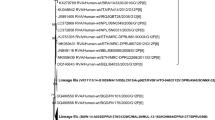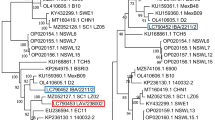Abstract
Virological surveillance is an important element in the Polio Eradication Initiative to provide information rapidly about circulating wild polioviruses. Molecular tools have been developed to identify the serotype of the poliovirus strains and whether they are of vaccine or wild origin (intratypic differentiation) and to perform the molecular epidemiology of wild strains. The main objective of this study was to show that restriction fragment length polymorphism (RFLP) is a tool that can be used for molecular epidemiology of wild polioviruses. This is retrospective study of poliovirus type 1 strains received at the Institut Pasteur of Bangui (IPB), a WHO Regional Reference Laboratory for Africa, since 1994. We describe our experience with isolates from Western and Central Africa and show a positive correlation between the genotypes as determined by sequencing the gene for the VP1 capsid protein and the RFLP patterns. Although genomic sequencing is the gold standard method for detailed molecular epidemiology analysis of poliovirus isolates, these results show that RFLP is a potentially valuable tool for molecular epidemiological analysis of poliovirus type 1 strains: it could be used by many laboratories as a rapid method for ITD and genotype screening where sequencing capacity is not readily available.



Similar content being viewed by others
References
Anonymous (2006) Imported vaccine-associated paralytic poliomyelitis-Unated States, 2005. MMWR Morb Mortal Wkly Rep 55:97–99
Anonymous (2006) Resurgence of Wild Poliovirus Type 1 Transmission and Consequences of Importation-21 Countries, 2002–2005. MMWR Morb Mortal Wkly Rep 55:145–150
Balanant J, Guillot S, Candrea A, Delpeyroux F, Crainic R (1991) The natural genomic variability of poliovirus analyzed by a restriction frangment length polymorphism assay. Virology 184:645–654
Gouandjika I, Legall P, Kelembo EK, Mathiot CC, Morvan JM (1995) Change in the type of wild poliovirus circulating in the Central African Republic between 1991 and 1994. Trans R Soc Trop Med Hyg 89:576
Kew O, Morris-Glasgow V, Landaverde M, Burns C, Shaw J, Garib Z, Andre J, Blackman E, Freeman CJ, Jorba J, Sutter R, Tambini G, Venczel L, Pedreira C, Laender F, Shimizu H, Yoneyama T, Miyamura T, van Der Avoort H, Oberste MS, Kilpatrick D, Cochi S, Pallansch M, de Quadros C (2002) Outbreak of poliomyelitis in Hispaniola associated with circulating type 1 vaccine-derived poliovirus. Science 296:356–359
Kew OM, Mulders MN, Lipskaya GY, da Silva EE, Pallansch MA (1995) Molecular epidemiology of polioviruses. In: Kew ON (ed) Molecular Epidemiology. Seminars in Virology. Academic, New York, pp 401–414
Kew OM, Yang CF, Nottay B, Pallansch MA (1993) The role of virologic surveillance in the global initiative to eradicate poliomyelitis. In: Kurstak E (ed) Control of virus diseases, 2nd edn., Marcel Dekker, New York, pp 215–245
Kimura M (1980) A simple method for estimating evolutionary rates of base substitutions through comparative studies of nucleotide sequences. J Mol Evol 16:111–120
Liu HM, Zheng DP, Zhang LB, Oberste MS, Pallansch MA, Kew OM (2000) Molecular evolution of a type 1 wild-vaccine poliovirus recombinant during widespread circulation in China. J Virol 74:11153–11161
Morvan JM, Chezzi C, Gouandjika I, Reimerink JH, van der Avoort HG (1997) The molecular epidemiology of type 1 poliovirus in Central African Republic. J Gen Virol 78(Pt 3):591–599
Moss EG, O’Neill R, Racaniello VRM. o. a. s. o. a. a. p. t. s. J. V. (1989) Mapping of atttenuating sequences of an avirulent poliovirus type 2 strain. J Virol 63:1884–1890
Rico-Hesse R, Pallansch MA, Nottay BK, Kew OM (1987) Geographic distribution of wild poliovirus type 1 genotypes. Virology 160:311–322
Saitou N, Nei M (1987) The neighbor-joining method: a new method for reconstructing phylogenetic trees. Mol Biol Evol 4:406–425
van der Avoort HG, Hull BP, Hovi T, Pallansch MA, Kew OM, Crainic R, Wood DJ, Mulders MN, van Loon AM (1995) Comparative study of five methods for intratypic differentiation of polioviruses. J Clin Microbiol 33:2562–2566
Ward NA, Kim-Farley RJ, Milstein JB, Hull HF, Torel C, de Quadros C (1993) Poliomyelitis eradication. Expanded programme on immunization of the World Health Organization. In: Kurstak E (ed) Control of virus diseases, 2nd edn. Marcel Dekker, New York, pp 247–266
WHO (1997) Manual for the virological investigation of polio. In WHO/EPI/GEN/97.01. World Health Organization
WHO (2000) Global polio eradication initiative. Strategic plan 2001–2005. WHO/POLIO/00.05. World Health Organization, Geneva
WorldHealthAssembly (1988) Global eradication of poliomyelitis by the year 2000: resolution of the 41st World Health Assembly. World Health Organization (WHA resolution no. 41.28), Geneva, Switzerland
Wright PF, Kim-Farley RJ, de Quadros CA, Robertson SE, Scott RM, Ward NA, Henderson RH (1991) Strategies for the global eradication of poliomyelitis by the year 2000. N Engl J Med 325:1774–1779
Acknowledgments
We would like to thank Antoine Talarmin for useful discussions, Arthur Mazitchi and Jean Fandema for performing the ITD testing of the strains, Jacqueline Quay and Jane Iber for sequencing some of the isolates, and Paul Chenoweth and Qi Chen for assistance with data organization and analysis. Strains from Cameroon were sent by Emmanuel Tina-Abada, from Centre Pasteur de Yaounde, in 2002. This work was supported in part by a grant from the WHO and by the French Ministry for Research. It was also supported by grants from the Direction of Foreign Affairs and from the Transverse Research Programs (PTR120) of the Pasteur Institute and from the French Ministry of Foreign Affairs (FSP 2001-168). The findings and conclusions in this report are those of the authors and do not necessarily reflect the views of the funding agency.
Author information
Authors and Affiliations
Corresponding author
Additional information
The GenBank accession numbers of the sequences reported in this paper are AY618419 to AY618458.
Rights and permissions
About this article
Cite this article
Gouandjika-Vasilache, I., Burns, C.C., Gumede, N. et al. Molecular epidemiology of wild poliovirus type 1 circulation in West and Central Africa, from 1997 to 1999, using genotyping with a restriction fragment length polymorphism assay. Arch Virol 153, 409–416 (2008). https://doi.org/10.1007/s00705-007-0001-x
Received:
Accepted:
Published:
Issue Date:
DOI: https://doi.org/10.1007/s00705-007-0001-x




